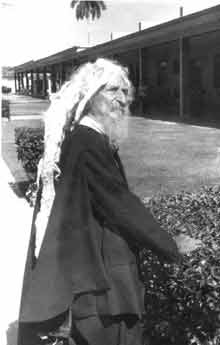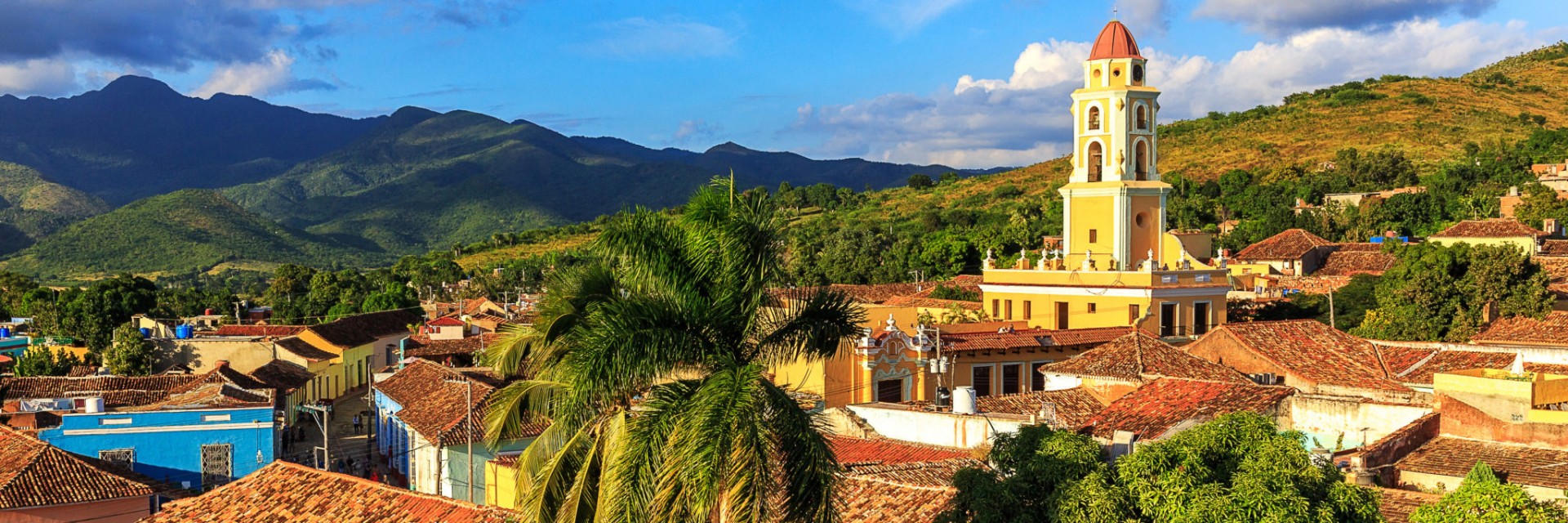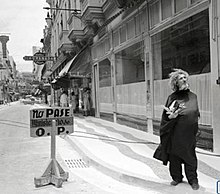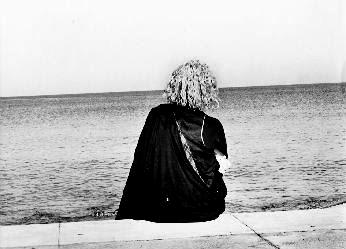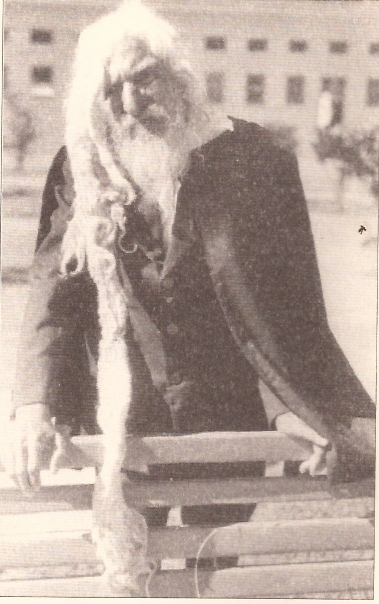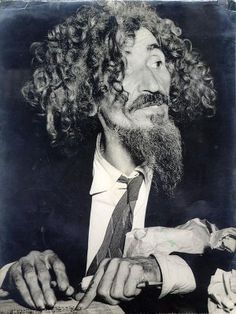 EL CABALLERO DE PARIS, UNA LEYENDA INOLVIDABLE DEL FOLCLCORE CUBANO. VIDEO.
EL CABALLERO DE PARIS, UNA LEYENDA INOLVIDABLE DEL FOLCLCORE CUBANO. VIDEO.
El Caballero de Paris es un mitico personaje quien encarna uno de los peldaños más altos de esas leyendas de figuras callejeras que rodean las memorias del folclore cubano y que forma parte de la historia capitalina de los últimos 50 años del pasado siglo.
Su verdadero nombre era José María Lledín, para los cubanos era y será siempre “El Caballero de Paris”, quien se paseaba por las calles y viajaba en los ómnibus de La Habana, saludando a todo el mundo y discutiendo la filosofía de su vida, la religión, la política y los eventos del día con todo el que atravesaba su camino.
Son muchos los habaneros que lo vieron deambular, durante años, por las capitalinas calles del Paseo del Prado, la Avenida del Puerto, en un parque cerca de la “Plaza de Armas”; cerca de la Iglesia de Paula; y en el Parque Central, donde algunas veces dormía en uno de los bancos; y solía caminar por la calle Muralla, Infanta y San Lázaro y por la esquina de 12 y 23, en el Vedado.
De mediana estatura, menos de seis pies, tenía el pelo muy largo y desaliñado, lucía barba y sus uñas eran largas y retorcidas por no haberse cortado en muchos años. Vestido siempre de negro, con una capa de igual color, incluso en el calor del verano. Siempre llevaba en las manos un cartapacio de papeles y periódicos, patrimonio de sus pertenencias, que parecía no querer desprenderse de ellos. Aunque los niños inicialmente le tenían miedo por su apariencia, pronto perdían el miedo y charlaban con él y tanto adultos como niños, le hablaban con mucho respeto.
Parte de sus delirios constituían su linaje cuando decía ser un gladiador, otras un corsario o un rey y hasta un emperador. Amable y locuaz solía contar con precisión las fechas de eventos ocurridos en pasadas épocas y disertaba de la nobleza si hubiera formado parte de ello, y tampoco le narrar que en una ocasión compartió con su Santidad el Papa.
Muchas son las teorías que envuelven su apodo, una de ellas relata que lo obtuvo de una novela francesa, en otra ocasión dijo a su biógrafo que la gente empezó a llamarlo “El Caballero” en la Acera del Louvre, del Paseo del Prado del Prado; y quizás, en su mente, la Acera del Louvre equivalía a París. Él decía que La Habana era “…muy parisién”.
Lo cierto es que “El Caballero de Paris”, o José María Lledin, nació en Fonsagrada, provincia de Lugo, en Galicia, España, el 30 de diciembre de 1899 y fue el único, de once hermanos que aprendió a leer y a escribir. Dicen que dedicó muchísimas horas a completar su educación, no pudo concluir sus estudios de Bachillerato, pero siempre prefirió la lectura y la buena música. Llegó a Cuba sin haber cumplido los quince años de edad y trabajó en diferentes actividades, como suelen hacer los emigrados y se dice que trabajó como sirviente de restaurante en los hoteles Inglaterra, Telégrafo, Sevilla, Manhattan, Royal Palm, Salón A y Saratoga.
Se cuenta que perdió el equilibrio mental después de haber sufrido prisión en El Castillo del Príncipe en La Habana, de manera injusta por un delito que no cometió, tras su excarcelación y a partir de las primeras décadas del siglo XX comenzó a deambular por las calles devenido personaje popular que cambiaba de personalidad y que le acompaño hasta su muerte.
El 7 de Diciembre de 1977, cercano a sus 90 años, se le vio por las calles hasta que fue necesario internarlo en el Hospital Psiquiátrico de La Habana en las afueras de la ciudad, para tratar de mejorar su delicado estado mental. Su psiquiatra el Dr. Luis Calzadilla Fierro, último acompañante de sus días a quien llamo su fiel mosquetero dictamino que padecía de parafrenia, delirio imaginativo con confabulaciones y un deterioro no significativo de la personalidad.
La historia de vida está recogida en un libro del Dr. Luis Calzadilla Fierro, titulado Yo soy el Caballero de París publicado en el año 2000, en el que publica una copia fotográfica del certificado de nacimiento y la lista de entradas de pasajeros cuando él llegó a Cuba y una copiosa documentación hasta el reporte de su autopsia.
“El Caballero” confesó a Calzadilla que nunca se había casado, pero que tenía un hijo y una hija de una señora que era secretaria de una compañía azucarera. También le contó que su hijo vivía en Marianao y trabajaba en la radio, y que la madre e hija se habían ido de Cuba.
El 11 de julio de 1985, el caballero andante de las calles habaneras se despidió de este mundo, pero según se cree antes de partir recobró algo de lucidez. Cuenta su doctor que, aquel día de su muerte, Lledín inició un curioso diálogo como si quisiera despedirse de él para siempre: -Lo encuentro tranquilo, sereno, como alguien que al fin ha logrado la paz consigo mismo.
– Buenas tardes, Caballero.
– Buenas tardes, Calzadilla. Te esperaba y por favor no me llames más
Caballero -contesta al saludo, en voz muy baja, casi inaudible (…).
– ¿Por qué no quiere que le llame Caballero? -preguntó curioso.
– Ya no soy el Caballero de París. Estos no son tiempos de aristócratas ni de caballeros andantes.
– ¿Ya yo no soy tampoco, su fiel mosquetero? -preguntó.
– No, Calzadilla, desde hace años sólo eres mi fiel psiquiatra.”
Estas y otras confesiones fueron registradas por el Dr.Calzadilla en su libro Yo soy el caballero de París y en cuya dedicatoria se puede leer: “A la memoria del loco más cuerdo que haya conocido jamás (…) de su psiquiatra y fiel mosquetero.”
No importa su desaparición física de las calles pues quedan sus andanzas, ahora en el imaginario popular, en el recuerdo y en las leyendas de esa Habana que lo eternizó. Lo evocamos cada día los miles de transeúntes que podemos verlo o tocarlo, en una estatua de bronce, de tamaño natural, fruto del escultor José Villa Sobaron, ubicada en las afueras del Convento de San Francisco de Asís, del Centro Histórico.
 THE KNIGHT OF PARIS (EL CABALLERO DE PARIS), UNFORGETTABLE LEGEND OF THE CUBAN FOLKLORE.VIDEO.
THE KNIGHT OF PARIS (EL CABALLERO DE PARIS), UNFORGETTABLE LEGEND OF THE CUBAN FOLKLORE.VIDEO.
The Knight of Paris is a mythical character who embodies one of the highest rungs of those legends of street figures, surrounded by Cuban folklore and is part of the capital’s history of the last 50 years of the last century.
His real name was José María Lledín, for Cubans he was and will always be “The Knight of Paris”, who walked through the streets and traveled on buses in Havana, greeting everyone and discussing the philosophy of his life, religion, politics and the events of the day with everyone who crossed their path.
We are many Havanans who saw him wander, for years, through the capital streets of Paseo del Prado, Avenida del Puerto, in a park near the “Plaza de Armas”; near the Church of Paula; and in Central Park, where he sometimes slept in one of the banks; and he used to walk along Muralla, Infanta and San Lázaro street and on the corner of 12 and 23, in Vedado.
Of medium height, less than six feet, he had very long and disheveled hair, looked beard and his nails were long and twisted for not having cut in many years. Always dressed in black, with a coat of equal color, even in the heat of summer. He always had in his hands a paper folder and papers, heritage of his belongings, which seemed not to want to part with them. Although the children initially were afraid of him because of his appearance, they soon lost their fear and chatted with him and both adults and children, they spoke to him with great respect.
Part of his delusions constituted his lineage when he claimed to be a gladiator, others a privateer or a king and even an emperor. Kind and talkative he used to count precisely the dates of events that occurred in past times and spoke of the nobility if he had been part of it, and he also did not tell him that on one occasion he shared with his Holiness the Pope.
There are many theories that surround his nickname, one of them tells that he obtained it from a French novel, on another occasion he told his biographer that people began to call him “The Knight” on the Sidewalk of the Louvre, on the Prado del Prado Promenade; and perhaps, in his mind, the Sidewalk of the Louvre was equivalent to Paris. He said that Havana was “… very Parisian.”
The truth is that “The Knight of Paris”, or José María Ledin, was born in Fonsagrada, province of Lugo, in Galicia, Spain, on December 30, 1899, and was the only one of eleven brothers who learned to read and write. They say that he spent many hours completing his education, he could not finish his Baccalaureate studies, but he always preferred reading and good music. He arrived in Cuba without having turned fifteen years of age and worked in different activities, as emigrants usually do and it is said that he worked as a restaurant servant in England, Telegraph, Seville, Manhattan, Royal Palm, Salon A, and Saratoga hotels.
It is said that he lost his mental balance after having suffered imprisonment in El Castillo del Príncipe in Havana, unfairly for a crime he did not commit, after his release and from the first decades of the twentieth century he began to roam the streets become popular character who changed personality and who accompanied him until his death.
On December 7, 1977, close to his 90s, he was seen in the streets until it was necessary to admit him to the Psychiatric Hospital of Havana on the outskirts of the city, to try to improve his delicate mental state. His psychiatrist Dr. Luis Calzadilla Fierro, the last companion of his days whom I call his faithful musketeer dictates that he suffered from paraphrenia, imaginative delirium with confabulations and a non-significant deterioration of personality.
The life story is collected in a book by Dr. Luis Calzadilla Fierro, entitled I am the Knight of Paris published in 2000, in which he publishes a photographic copy of the birth certificate and the list of passenger tickets when he arrived in Cuba and copious documentation until the autopsy report.
“El Caballero” confessed to Calzadilla that he had never married, but that he had a son and daughter of a lady who was secretary of a sugar company. He also told him that his son lived in Marianao and worked on the radio and that the mother and daughter had left Cuba.
On July 11, 1985, the walking knight of the Havana streets said goodbye to this world, but as it is believed before leaving, he recovered some lucidity. His doctor says that, on the day of his death, Lledín began a curious dialogue as if he wanted to say goodbye to him forever: -I find him calm, serene, as someone who has finally achieved peace with himself.
– Good afternoon gentleman.
– Good afternoon, Calzadilla. I was waiting for you and please don’t call me anymore
Gentleman -he replies to the greeting, in a very low voice, almost inaudible (…).
– Why don’t you want to be called Caballero? he asked curiously.
– I’m not the Knight of Paris anymore. These are not times of aristocrats or walking knights.
– I’m not his faithful musketeer either? -I ask.
– No, Calzadilla, for years you are only my faithful psychiatrist. ”
These and other confessions were recorded by Dr. Calzadilla in his book I am the gentleman of Paris and whose dedication you can read: “To the memory of the most sane madman who has ever known (…) his psychiatrist and faithful musketeer.”
It does not matter his physical disappearance from the streets because his adventures remain, now in the popular imagination, in the memory and in the legends of that Havana that eternalized him. We recall every day the thousands of passersby that we can see or touch, in a life-sized bronze statue, the fruit of the sculptor José Villa Sobaron, located on the outskirts of the Convent of San Francisco de Asís, of the Historic Center.
Agencies/ Wiki/ RHC/ Nuria Barbosa/ Extractos/ Excerpts/ Internet Photos/ Arnoldo Varona/ www.TheCubanHistory.com
THE CUBAN HISTORY, HOLLYWOOD.





